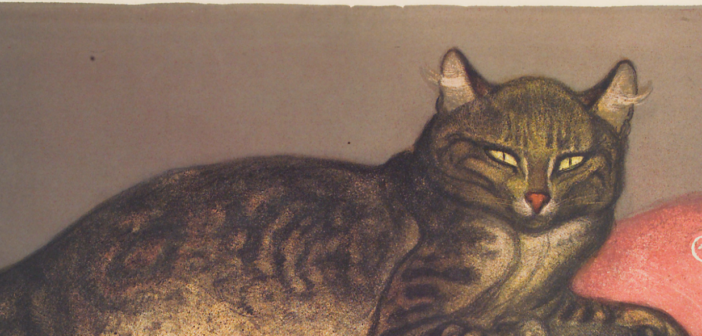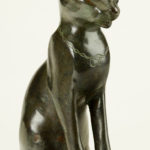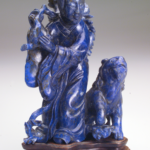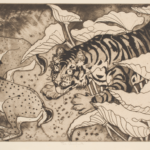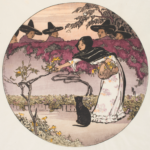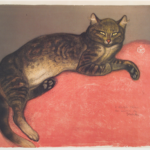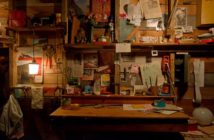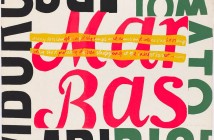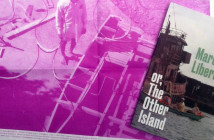From 1759 to 1763, writer Christopher Smart composed the sprawling poem Jubilate Agno while confined to an asylum. The best-known portion of the text is a 74-line segment in which Smart expounds on the ways that his cat is an ideal servant of God, a long passage where he describes daily feline behaviors in gushing detail in an attempt to exalt them as signs of religious fervor. Long before Jubilate Agno, and now, long after, cats have served as artistic subject matter, whether elevated or banal. Under the simple header MEOW, the Worcester Art Museum is currently host to concurrent exhibitions that span this breadth of engagement with cats.
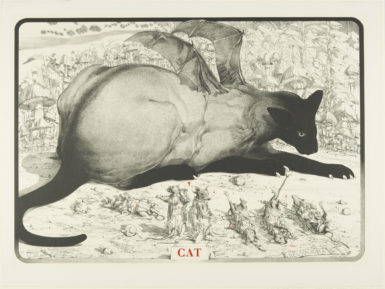
Robert A. Nelson
Cat and Mice, 1975
color lithograph on cream wove paper
Gift of The Boston Printmakers
1976.43
© Robert A. Nelson, used with permission.
The Captivating Cat: Felines and the Artist’s Gaze serves as the centerpiece of the museum-wide theme. Though it is billed as a special exhibition, it pulls an impressive range from the WAM’s permanent collection. Some of the work is fantastical: Robert A. Nelson’s Cat and Mice, for instance, is a lithograph that shows a winged purebred at war with an army of mice. Some of the images of wild cats are clearly more imagined than observed. An array of these works deal with the relationship between the feline and the feminine. More often than not the artwork centers on domesticated cats, however, and by extension depicts fairly ordinary scenes that remain constant despite differences in time and culture. Worcester photographer Frederick K Coulson’s 1894 cyanotype of a striped housecat lounging under a window is paired with a lithograph of a cougar by M.E.D. Brown, teasing out the similarities in pose and persona in big and little cats. What’s more striking is that this cyanotype—and Coulson’s other prints featured in the gallery—are hard to distinguish from a contemporary snapshot, and that thread offers more on the impulse to depict cats than some of the thematic groupings in the gallery. The first half of the exhibition’s run coincided with a Community Cat Show, an all-ages open call for work that hung in the museum’s Higgins Education Wing. With a visible range from amateur to professional work, the show was almost entirely pet portraiture, and considered alongside Coulson’s prints, or Will Barnet’s ordinary, familial scenes of women and cats, the feline comes across as a pleasantly mundane subject. Whether cats’ independent tendencies make them good studio companions, easy and economical to turn to as any subject during artistic blocks, or one step removed from the navel-gazing trap of working in solitude, or whether artists are just particularly vulnerable to toxoplasmosis, there is no shortage of the compulsion to make this kind of art. It can feel flat to view this autobiographical relationship between artist and animal companion from the outside, but when it is good, it is superb.
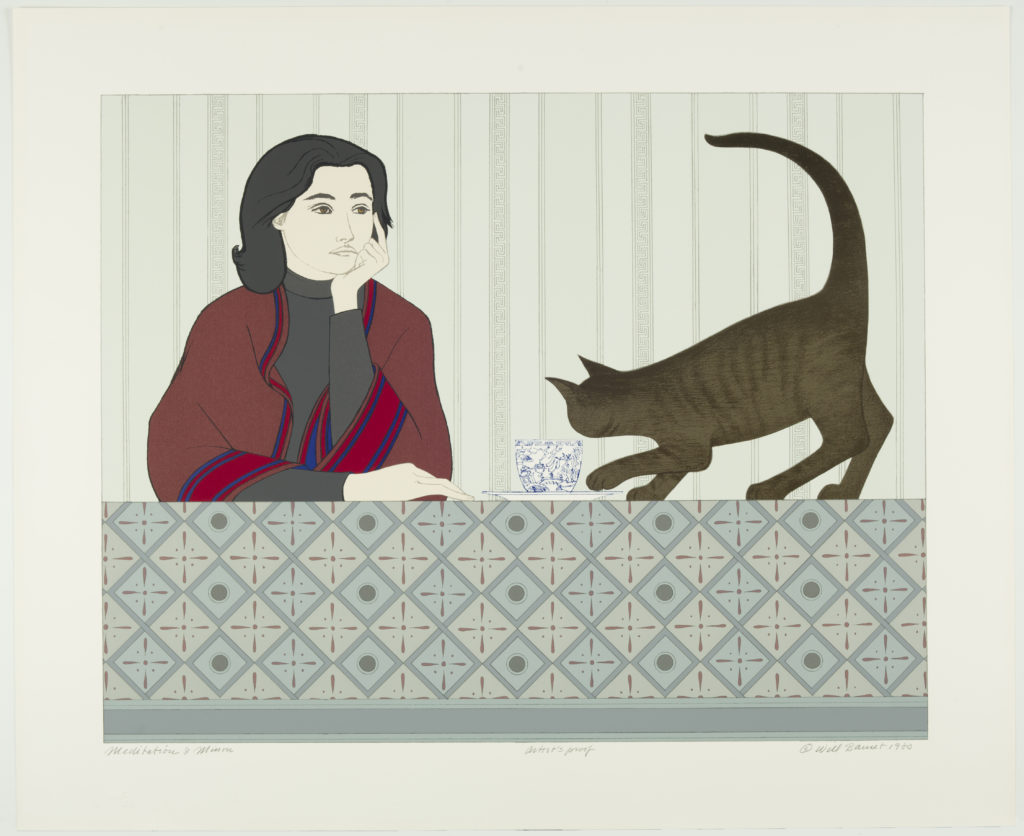
Will Barnet
Meditation and Minou, 1980
Gift of the Artist
1994.196
© Will Barnet Trust/Licensed by VAGA, New York, NY
Alexandre Gallery, New York, NY
Separate from The Captivating Cat is the Cats in Residence program, a traveling social sculpture project housed in a studio classroom. Created and curated by artist Rhonda Liebermann, the “CatAviary” enclosure and attending artworks become a temporary home to local cats who are up for adoption, attempting to celebrate the animals and charging artists with the task of elevating the typical shelter experience. The CatAviary is functioning at the WAM mostly in a utilitarian way, as a temporary satellite adoption site cared for by the Worcester Animal Rescue League. This may or may not reflect success as an installation, though at the time of this writing ten cats from WARL have been adopted out of the Cats in Residence program, which is a straightforward enough success. Most of the work in the CatAviary is part sculpture, part infrastructure: carpeted pallets and scratching posts, ceramic food and water dishes, and plentiful napping perches and places to hide, all created by artists and designers. The installation is familiar enough in form that it seems underappreciated by human visitors, though the cats are adept at utilizing all that has been offered to them. A few stand-outs do jump out to those looking to view the work in an art context. Lisa Anne Auerbach’s Scraps, Mistakes, and Failures... are trial runs or cast-offs from her typical knitwear artworks, sewn into cat beds in an economical and generous turn, since studio errors and dead end projects so rarely see the light of day lest they reflect poorly on the rest of a body of work. Rob Pruitt’s Zen Litter Tray is a functional litter box styled with a small wooden rake and a scholar’s rock. Best of all is Theo Rosenblum and Chelsea Seltzer’s Beppe Bigazzi (Cat Scratch Fever), a grinning bust of the celebrity chef who lost his television contract in 2010 after touting stewed cat meat as a delicacy during a live broadcast. The sculpture is partially covered in a thick layer of catnip, and it is in constant use as the cats attempt to lick it clean.
In addition to the primary exhibitions, a map for a self-guided tour is available to locate other artworks that feature cats. The Worcester Hunt Antioch mosaic is the first item on the “Catwalk,” located immediately behind the Salisbury Street entrance, and from there the list takes the viewer to all collection areas, with objects from around the world dating from 600 BC to the present. Some are straightforward depictions of cats, domestic or wild, or works that incorporate the creatures as design elements in family crests or everyday items. A handful of objects widen the focus a bit: a Greek Amphora shows Herakles dressed in the skin of the Nemean lion, and the tour concludes at The Questioner of the Sphinx, Elihu Vedder’s 19th-century turn at understanding the cat’s significant role in ancient Egypt. The tour is unified by a set of new gallery texts, which provide context for each of the works with regard to the feline theme, even if they do not help to draw broader conclusions across the tour. The best thing about the Catwalk may be that it offers a new framework for taking a fairly quick yet thorough lap around the collection. The WAM is a manageable size to see in a single day, and any program that draws new visitors to less-frequented permanent galleries or opens up new ways of looking for returning guests is a net positive.
MEOW is open through September 4. Admission to the Worcester Art Museum is free for the month of August.
*Jubilate Agno, Christopher Smart.
- Egyptian Cat, 26th Dynasty (672-525 BCE) Museum Purchase 1947.7
- Chinese Female Figure with Peony Branch, Accompanied by a Lion, Qing Dynasty lapis lazuli Bequest of Mrs. Harry W. Goddard, in memory of Harry W. Goddard 1938.28
- Orovida Camille Pissarro The Ambush, 1938 etching and aquatint on cream laid paper Museum Purchase 1940.302 © Estate of Orovida Pissarro, used with permission.
- Helen Hyde A Mexican Coquette, 1912 woodcut on cream Japan paper Anonymous Gift 1988.78
- Theophile Alexandre Steinlen The Cat in Winter, 1909 lithograph on cream wove paper Sarah C. Garver Fund

